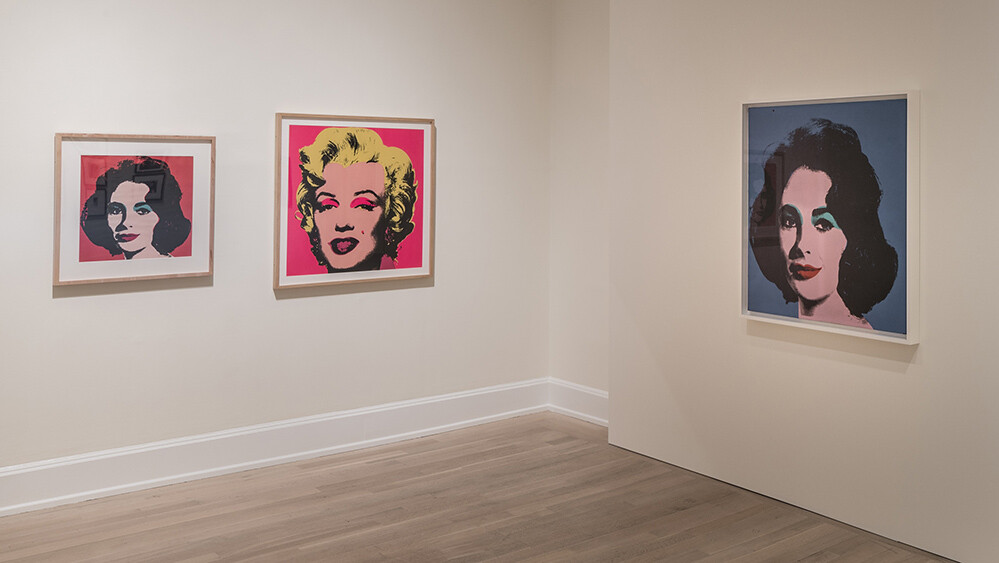September 25, 2015–February 7, 2016
1109 Fifth Ave
New York, NY 10128
USA
The public personas of Elizabeth Taylor and Marilyn Monroe were constructed, but when they converted to Judaism, the change for both women was personal and profound. Becoming Jewish: Warhol’s Liz and Marilyn draws parallels between the actresses’ identities as Jewish women and Warhol’s exploration of their celebrity through his image-making.
“Marilyn was a myth,” wrote the journalist Max Lerner in 1962. “And Liz is a legend.” Andy Warhol’s iconic portraits of Marilyn Monroe and Elizabeth Taylor reflect this sentiment. Elizabeth and Marilyn enthralled him: they were beauty, success, and fame personified.
In the 1960s, the cultural power of these two screen goddesses was immeasurable. Fans, including Andy, fixated on their lives. He was, as always, drawn to the dark side of celebrity, interested not only in their screen triumphs, but also their troubled marriages, illness, and the rumors that filled the gossip magazines. As he once said, “Everybody needs a fantasy.”
While their families and love affairs were widely reported on, Monroe and Taylor managed to preserve personal lives separate from their public personas. Thus, the conversion of both women to Judaism remained private. Marilyn chose to become Jewish upon her marriage in 1956 to the playwright Arthur Miller, himself a Jew. She took the decision seriously, studying Judaic texts with the Miller family’s rabbi, Robert. E. Goldburg. Liz developed a spiritual and emotional connection to Judaism after the 1958 death in a plane crash of her producer husband, Mike Todd (born Avrom Hirsch Goldbogen). She converted the following year, and was a passionate supporter of Israel and Jewish philanthropies throughout her life.
Becoming Jewish: Warhol’s Liz and Marilyn explores Andy Warhol’s fascination with Marilyn Monroe and Elizabeth Taylor, and the tabloid world they embodied. His epochal paintings of the actresses in the 1960s coincided with the end of the Golden Age of Hollywood and an upsurge in consumer culture. Jewish consciousness and openly Jewish celebrity were also on the rise. The fact that Hollywood’s blonde bombshell and violet-eyed siren were both converted Jews was significant: it signaled a growing popular acceptance of Jewish public figures. Warhol’s portraits, both photographically familiar and disturbingly abstracted, explore the complex, manufactured nature of identity. His images cemented their status as the most glamorous women of their era, the twentieth century’s great myth and legend.
Related public programs
This Is How We Do It: Becoming Jewish: Warhol’s Liz and Marilyn
Thursday, January 14, 2pm
Joanna Montoya Robotham, Neubauer Family Foundation Assistant Curator, speaks about the process of organizing the exhibition.
Free with museum admission, RSVP recommended
Author Talk: Deborah Davis and Blake Gopnik
Monday, February 1, 6:30pm
Deborah Davis discusses her new book The Trip: Andy Warhol’s Plastic Fantastic Cross-Country Adventure, which chronicles the cross-country road trip that Warhol took from New York to Los Angeles in 1963, and illuminates how that journey—and the artists and celebrities whom Warhol met along the way—profoundly influenced his life and art. Davis will be joined by writer and critic Blake Gopnik, regular contributor to The New York Times and author of the upcoming biography Andy Warhol: A Life as Art.
For more information, check thejewishmuseum.org.
#WarholLizMarilyn
Becoming Jewish: Warhol’s Liz and Marilyn is organized by Joanna Montoya Robotham, Neubauer Family Foundation Assistant Curator.
This exhibition is made possible, in part, by the Neubauer Family Foundation.



